英语第一单元知识点梳理
- 格式:docx
- 大小:12.69 KB
- 文档页数:1
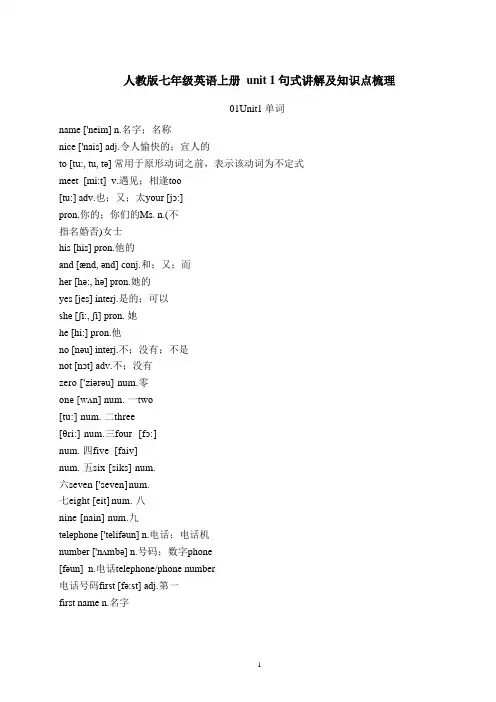
人教版七年级英语上册unit 1 句式讲解及知识点梳理01Unit1 单词name ['neim] n.名字;名称nice ['nais] adj.令人愉快的;宜人的to [tu:, tu, tə] 常用于原形动词之前,表示该动词为不定式meet [mi:t] v.遇见;相逢too[tu:] adv.也;又;太your [jɔ:]pron.你的;你们的Ms. n.(不指名婚否)女士his [his] pron.他的and [ænd, ənd] conj.和;又;而her [hə:, hə] pron.她的yes [jes] interj.是的;可以she [ʃi:, ʃi] pron. 她he [hi:] pron.他no [nəu] interj.不;没有;不是not [nɔt] adv.不;没有zero ['ziərəu] num.零one [wʌn] num. 一two[tu:] num. 二three[θri:] num.三four [fɔ:]num. 四five [faiv]num. 五six [siks] num.六seven ['seven] num.七eight [eit] num. 八nine [nain] num.九telephone ['telifəun] n.电话;电话机number ['nʌmbə] n.号码;数字phone[fəun] n.电话telephone/phone number电话号码first [fə:st] adj.第一first name n.名字last [lɑ:st] adj.最后的;末尾的last name 姓friend [frend] n.朋友China ['tʃainə] 中国middle ['midl] adj.中间的n.中间school [sku:l] n.学校middle school 中学;初中Gina 吉娜(女名)Jenny ['dʒeni, 'dʒini] 珍妮(女名)Brown [braun] 布朗(姓)Alan ['ælən] 艾伦(男名)Tom [tɔm] 汤姆(男名)Mike [maik] 迈克(男名)Jack [dʒæk] 杰克(男名)Mary ['mɛəri] 玛丽(女名)Miller ['milə] 米勒(姓)Linda ['lində] 琳达(女名)Jane [dʒein] 简(女名)Green [gri:n] 格林(姓)Smith [smiθ] 史密斯(姓)02Starter Unit1 知识梳理【重点短语】1. my name 我的名字2.your name 你的名字3. her name 她的名字.4. his name 他的名字5. I’m .. . 我是……6. first name 名字7. last name/family name 姓氏8. Ms. Brown 布朗女士9. your school ID card 你的学生卡10. phone/telephone number 电话号码11. his ID card number 他的身份证号码12. my friend 我的朋友13. nice to meet you 很高兴见到你14. middle school 中学15. in China 在中国【重点句型】1. —What’s your name? 你叫什么名字?一I’m /M y name is Alan. 我叫艾伦。
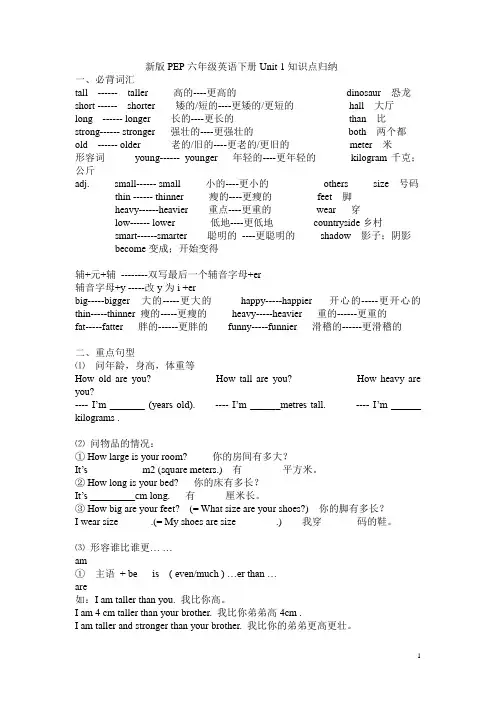
新版PEP六年级英语下册Unit 1知识点归纳一、必背词汇tall ------ taller 高的----更高的dinosaur 恐龙short ------ shorter 矮的/短的----更矮的/更短的hall 大厅long ------ longer 长的----更长的than 比strong------ stronger 强壮的----更强壮的both 两个都old ------ older 老的/旧的----更老的/更旧的meter 米形容词young------ younger 年轻的----更年轻的kilogram千克;公斤adj. small------ small 小的----更小的others size 号码thin ------ thinner 瘦的----更瘦的feet 脚heavy------heavier 重点----更重的wear 穿low------ lower 低地----更低地countryside乡村smart------smarter 聪明的----更聪明的shadow 影子;阴影become变成;开始变得辅+元+辅--------双写最后一个辅音字母+er辅音字母+y -----改y为i +erbig-----bigger 大的-----更大的happy-----happier 开心的-----更开心的thin-----thinner 瘦的-----更瘦的heavy-----heavier 重的------更重的fat-----fatter 胖的------更胖的funny-----funnier 滑稽的------更滑稽的二、重点句型⑴问年龄,身高,体重等How old are you? How tall are you? How heavy are you?---- I’m _______ (years old). ---- I’m ______metres tall. ---- I’m ______ kilograms .⑵问物品的情况:① How large is your room? 你的房间有多大?It’s __________ m2 (square meters.) 有_______ 平方米。
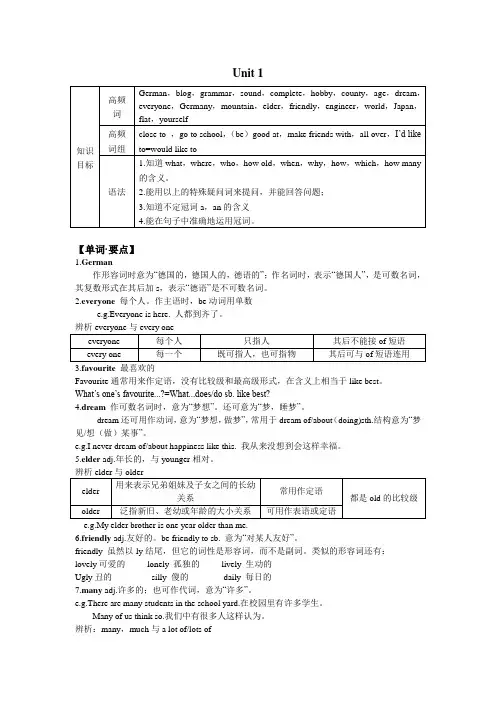
Unit 1知识目标高频词German,blog,grammar,sound,complete,hobby,county,age,dream,everyone,Germany,mountain,elder,friendly,engineer,world,Japan,flat,yourself高频词组close to ,go to school,(be)good at,make friends with,all over,I’d liketo=would like to语法1.知道what,where,who,how old,when,why,how,which,how many的含义。
2.能用以上的特殊疑问词来提问,并能回答问题;3.知道不定冠词a,an的含义4.能在句子中准确地运用冠词。
【单词·要点】1.German作形容词时意为“德国的,德国人的,德语的”;作名词时,表示“德国人”,是可数名词,其复数形式在其后加s,表示“德语”是不可数名词。
2.everyone 每个人。
作主语时,be动词用单数e.g.Everyone is here. 人都到齐了。
辨析everyone与every oneeveryone 每个人只指人其后不能接of短语every one 每一个既可指人,也可指物其后可与of短语连用3.favourite 最喜欢的Favourite通常用来作定语,没有比较级和最高级形式,在含义上相当于like best。
What’s one’s favourite...?=What...does/do sb. like best?4.dream作可数名词时,意为“梦想”。
还可意为“梦,睡梦”。
dream还可用作动词,意为“梦想,做梦”,常用于dream of/about(doing)sth.结构意为“梦见/想(做)某事”。
e.g.I never dream of/about happiness like this. 我从来没想到会这样幸福。
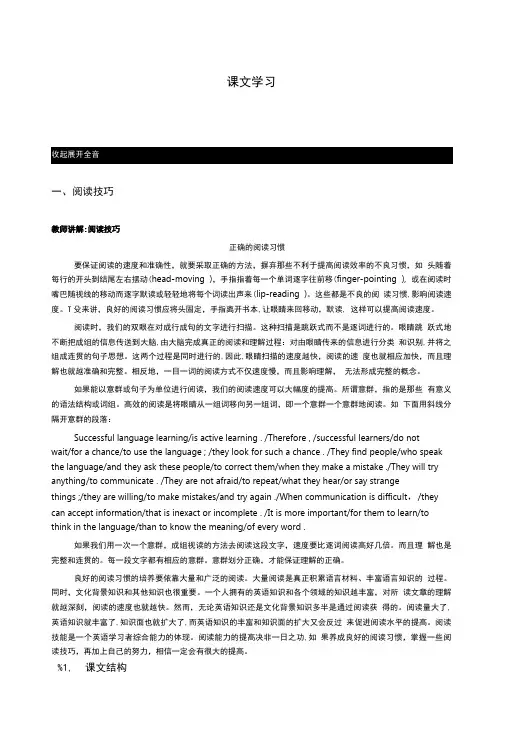
课文学习一、阅读技巧教师讲解:阅读技巧正确的阅读习惯要保证阅读的速度和准确性,就要采取正确的方法,摒弃那些不利于提高阅读效率的不良习惯,如头随着每行的开头到结尾左右摆动(head-moving ),手指指着每一个单词逐字往前移(finger-pointing ), 或在阅读时嘴巴随视线的移动而逐字默读或轻轻地将每个词读出声来(lip-reading )。
这些都是不良的阅读习惯,影响阅读速度。
T殳来讲,良好的阅读习惯应将头固定,手指离开书本,让眼睛来回移动,默读, 这样可以提高阅读速度。
阅读时,我们的双眼在对成行成句的文字进行扫描。
这种扫描是跳跃式而不是逐词进行的。
眼睛跳跃式地不断把成组的信息传送到大脑,由大脑完成真正的阅读和理解过程:对由眼睛传来的信息进行分类和识别,并将之组成连贯的句子思想。
这两个过程是同时进行的,因此,眼睛扫描的速度越快,阅读的速度也就相应加快,而且理解也就越准确和完整。
相反地,一目一词的阅读方式不仅速度慢,而且影响理解,无法形成完整的概念。
如果能以意群或句子为单位进行阅读,我们的阅读速度可以大幅度的提高。
所谓意群,指的是那些有意义的语法结构或词组。
高效的阅读是将眼睛从一组词移向另一组词,即一个意群一个意群地阅读。
如下面用斜线分隔开意群的段落:Successful language learning/is active learning . /Therefore , /successful learners/do notwait/for a chance/to use the language ; /they look for such a chance . /They find people/who speak the language/and they ask these people/to correct them/when they make a mistake ./They will try anything/to communicate . /They are not afraid/to repeat/what they hear/or say strangethings ;/they are willing/to make mistakes/and try again ./When communication is difficult,/they can accept information/that is inexact or incomplete . /It is more important/for them to learn/to think in the language/than to know the meaning/of every word .如果我们用一次一个意群,成组视读的方法去阅读这段文字,速度要比逐词阅读高好几倍。
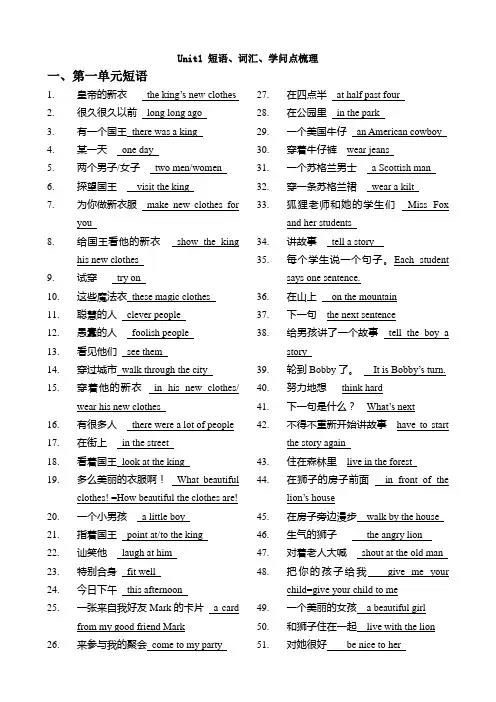
Unit1 短语、词汇、学问点梳理一、第一单元短语1.皇帝的新衣the king’s new clothes2.很久很久以前long long ago3.有一个国王there was a king4.某一天one day5.两个男子/女子two men/women6.探望国王visit the king7.为你做新衣服make new clothes foryou8.给国王看他的新衣show the kinghis new clothes9.试穿try on10.这些魔法衣these magic clothes11.聪慧的人clever people12.愚蠢的人foolish people13.看见他们see them14.穿过城市walk through the city15.穿着他的新衣in his new clothes/wear his new clothes16.有很多人there were a lot of people17.在街上in the street18.看着国王look at the king19.多么美丽的衣服啊!What beautifulclothes! =How beautiful the clothes are!20.一个小男孩 a little boy21.指着国王point at/to the king22.讪笑他laugh at him23.特别合身fit well24.今日下午this afternoon25.一张来自我好友Mark的卡片 a cardfrom my good friend Mark26.来参与我的聚会come to my party 27.在四点半at half past four28.在公园里in the park29.一个美国牛仔an American cowboy30.穿着牛仔裤wear jeans31.一个苏格兰男士 a Scottish man32.穿一条苏格兰裙wear a kilt33.狐狸老师和她的学生们Miss Foxand her students34.讲故事tell a story35.每个学生说一个句子。
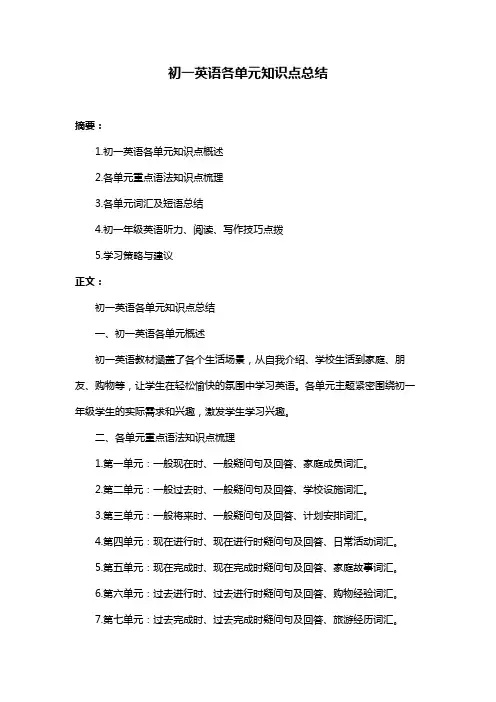
初一英语各单元知识点总结摘要:1.初一英语各单元知识点概述2.各单元重点语法知识点梳理3.各单元词汇及短语总结4.初一年级英语听力、阅读、写作技巧点拨5.学习策略与建议正文:初一英语各单元知识点总结一、初一英语各单元概述初一英语教材涵盖了各个生活场景,从自我介绍、学校生活到家庭、朋友、购物等,让学生在轻松愉快的氛围中学习英语。
各单元主题紧密围绕初一年级学生的实际需求和兴趣,激发学生学习兴趣。
二、各单元重点语法知识点梳理1.第一单元:一般现在时、一般疑问句及回答、家庭成员词汇。
2.第二单元:一般过去时、一般疑问句及回答、学校设施词汇。
3.第三单元:一般将来时、一般疑问句及回答、计划安排词汇。
4.第四单元:现在进行时、现在进行时疑问句及回答、日常活动词汇。
5.第五单元:现在完成时、现在完成时疑问句及回答、家庭故事词汇。
6.第六单元:过去进行时、过去进行时疑问句及回答、购物经验词汇。
7.第七单元:过去完成时、过去完成时疑问句及回答、旅游经历词汇。
8.第八单元:将来进行时、将来进行时疑问句及回答、梦想与理想词汇。
三、各单元词汇及短语总结1.第一单元:hello、hi、nice to meet you、family、mother、father、brother、sister、friend等。
2.第二单元:classroom、library、playground、teacher、student、schoolbag、pencil等。
3.第三单元:tomorrow、weekend、plan、activity、go swimming、go hiking等。
4.第四单元:now、breakfast、lunch、dinner、hobbies、sports等。
5.第五单元:yesterday、last week、last year、never、already、so far 等。
6.第六单元:shopping、store、market、price、bargaining、try on 等。
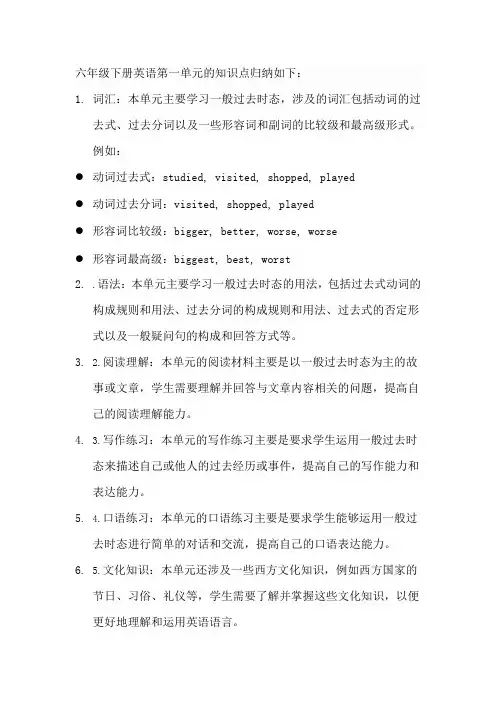
六年级下册英语第一单元的知识点归纳如下:
1.词汇:本单元主要学习一般过去时态,涉及的词汇包括动词的过
去式、过去分词以及一些形容词和副词的比较级和最高级形式。
例如:
●动词过去式:studied, visited, shopped, played
●动词过去分词:visited, shopped, played
●形容词比较级:bigger, better, worse, worse
●形容词最高级:biggest, best, worst
2..语法:本单元主要学习一般过去时态的用法,包括过去式动词的
构成规则和用法、过去分词的构成规则和用法、过去式的否定形式以及一般疑问句的构成和回答方式等。
3. 2.阅读理解:本单元的阅读材料主要是以一般过去时态为主的故
事或文章,学生需要理解并回答与文章内容相关的问题,提高自己的阅读理解能力。
4. 3.写作练习:本单元的写作练习主要是要求学生运用一般过去时
态来描述自己或他人的过去经历或事件,提高自己的写作能力和表达能力。
5. 4.口语练习:本单元的口语练习主要是要求学生能够运用一般过
去时态进行简单的对话和交流,提高自己的口语表达能力。
6. 5.文化知识:本单元还涉及一些西方文化知识,例如西方国家的
节日、习俗、礼仪等,学生需要了解并掌握这些文化知识,以便更好地理解和运用英语语言。
以上是六年级下册英语第一单元的主要知识点,学生需要认真学习和掌握这些知识点,以便更好地理解和运用英语语言。
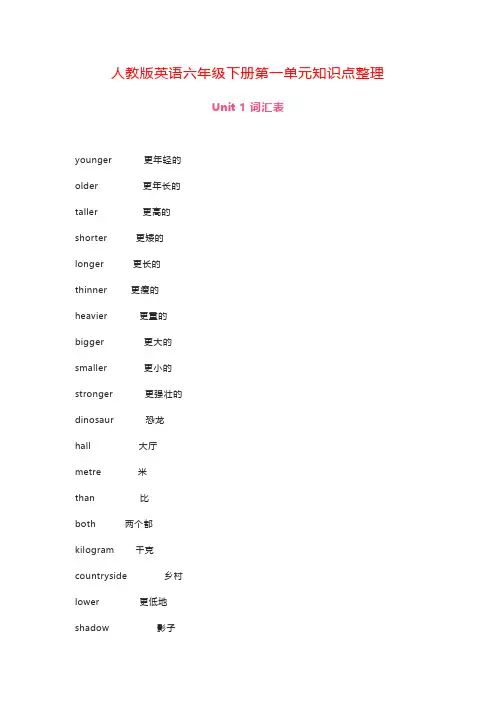
人教版英语六年级下册第一单元知识点整理Unit 1 词汇表younger 更年轻的older 更年长的taller 更高的shorter 更矮的longer 更长的thinner 更瘦的heavier 更重的bigger 更大的smaller 更小的stronger 更强壮的dinosaur 恐龙hall 大厅metre 米than 比both 两个都kilogram 千克countryside 乡村lower 更低地shadow 影子smarter 更聪明的become 变成知识点归纳第一单元知识要点归纳梳理Unit 1 How tall are you? 【重点词汇】形容词的原级和比较级tall------ taller 高的----更高的short ------ shorter 矮的/短的----更矮的/更短的long----- longer 长的----更长的strong------ stronger 强壮的----更强壮的old ------ older 老的/旧的----更老的/更旧的young------ younger 年轻的----更年轻的small------ small 小的----更小的heavy------heavier 重点----更重的thin ------ thinner 瘦的----更瘦的low------ lower 低地----更低地smart------smarter 聪明的 ----更聪明的big-----bigger 大的-----更大的happy-----happier 开心的-----更开心的thin-----thinner 瘦的-----更瘦的heavy-----heavier 重的------更重的fat-----fatter 胖的------更胖的funny-----funnier 滑稽的------更滑稽的【重点句型】⑴问年龄:How old are you? ----- I’m _______ (years old). 问身高:How tall are you? ---- I’m ______meters tall. 问题中:How heavy are you? ---- I’m ______ kilograms .⑵问物品的情况:①How large is your room?你的房间有多大?It’s __________ square meters.有_______ 平方米。

英语必修一第一单元知识点总结语言要点(模块)一、短语归纳1. 做个好朋友 to be a good friend2. 做下列调查 make the following survey3. 合计总分 add up the score4. 得分 get points5. 心烦意乱地来到学校come to school upset6. 不理会铃声 ignore the bell7. 使你那个德国朋友安静下来 calm down your German friend8. 关心你朋友 be concerned about your friend(s) 9. 松开了 get loose10. 不得不去户外遛狗 have got to walk the dog outdoors11. 帮他期末考试作弊 help him cheat in the end-of-term exam12. 列出理由make a list of reasons / list the reasons 13.记下一连串的要求 set down a series of requests14. 根据问卷调查 according to the questionnaire 15. 根据编辑的忠告 according to the editor’s advice16. 为了分担你的困难 in order to share your difficulties /troubles 17. 与老板相爱 fall in love with the boss18. 与我的同桌相处和谐 get along / on well with my deskmate19. 关心青少年 be concerned about teenagers20. 为了和老板面对面地交流 in order to communicate with theboss face to face21. 信任政府trust / believe in the government22. 经历了太多的战争 go through too many wars23. 相邻的城镇 neighboring towns 24. 相邻的国家 neighboring countries二、.词语辨析三.词性变化(旨在提供语法填空所需材料)四.重点辞汇1.survey n. 调查,勘察,检测The reporter made a survey of river pollution.短语make a survey of…做…调查。
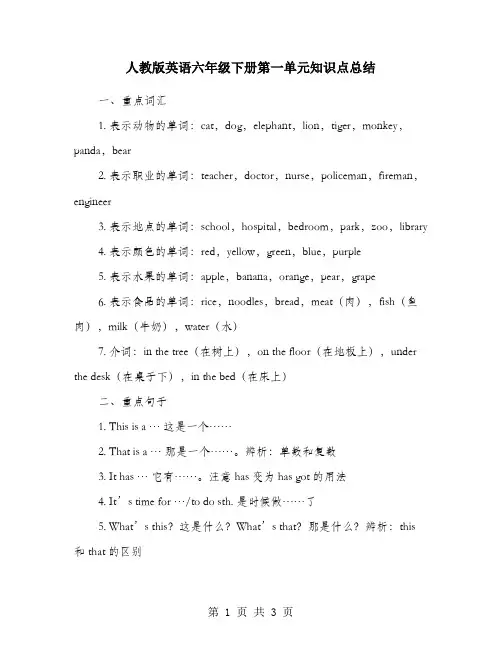
人教版英语六年级下册第一单元知识点总结一、重点词汇1. 表示动物的单词:cat,dog,elephant,lion,tiger,monkey,panda,bear2. 表示职业的单词:teacher,doctor,nurse,policeman,fireman,engineer3. 表示地点的单词:school,hospital,bedroom,park,zoo,library4. 表示颜色的单词:red,yellow,green,blue,purple5. 表示水果的单词:apple,banana,orange,pear,grape6. 表示食品的单词:rice,noodles,bread,meat(肉),fish(鱼肉),milk(牛奶),water(水)7. 介词:in the tree(在树上),on the floor(在地板上),under the desk(在桌子下),in the bed(在床上)二、重点句子1. This is a … 这是一个……2. That is a … 那是一个……。
辨析:单数和复数3. It has … 它有……。
注意has变为has got的用法4. It’s time for …/to do sth. 是时候做……了5. What’s this?这是什么?What’s that?那是什么?辨析:this 和that的区别6. Can you hear a …?你能听到……吗?用复数 hear 用法需要注意一下。
7. I like… 我喜欢……。
喜欢某事+Ving形式。
可以带to do sth或者doing sth。
记住以下词组:“喜欢的食物、水果、动物”等。
8. There be…有…… 句型表示某地有某物。
注意be动词的变化以及介词的使用。
9. I’m going to…我将要……。
记住 be going to的用法以及词组搭配。
10. Come and see me/my…来看我吧/我的……。
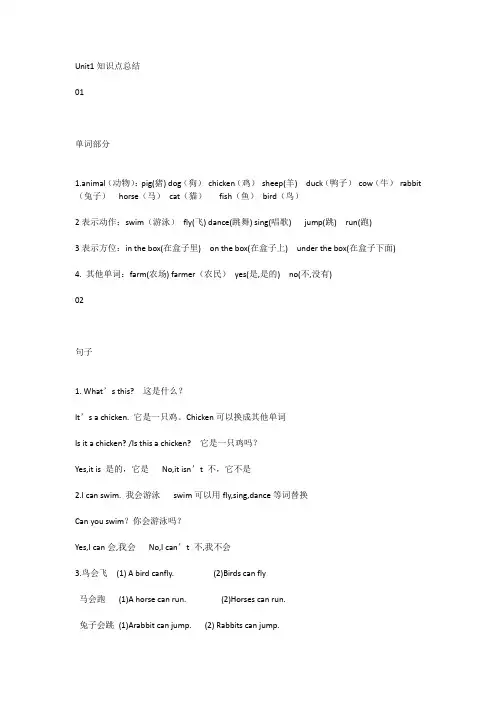
Unit1知识点总结01单词部分1.animal(动物):pig(猪) dog(狗)chicken(鸡)sheep(羊) duck(鸭子)cow(牛)rabbit (兔子)horse(马)cat(猫)fish(鱼)bird(鸟)2表示动作:swim(游泳)fly(飞) dance(跳舞) sing(唱歌) jump(跳) run(跑)3表示方位:in the box(在盒子里) on the box(在盒子上) under the box(在盒子下面)4. 其他单词:farm(农场) farmer(农民)yes(是,是的) no(不,没有)02句子1. What’s this? 这是什么?It’s a chicken. 它是一只鸡。
Chicken可以换成其他单词Is it a chicken? /Is this a chicken? 它是一只鸡吗?Yes,it is 是的,它是No,it isn’t 不,它不是2.I can swim. 我会游泳swim可以用fly,sing,dance等词替换Can you swim?你会游泳吗?Yes,I can会,我会No,I can’t 不,我不会3.鸟会飞(1) A bird canfly. (2)Birds can fly马会跑(1)A horse can run. (2)Horses can run.兔子会跳(1)Arabbit can jump. (2) Rabbits can jump.鱼会游泳Fishcan swim.4.A horse can run.马会跑Can a horse run? 马会跑吗?Yes, it can 会,它会No,it can’t 不,它不会5.What animalscan fly?什么动物会飞?Birds can fly.鸟会飞What animals can swim?什么动物会游泳?Fish can swim. 鱼会游泳Ducksand dogs can swim. 鸭子和狗会游泳。
新教材)人教版 2019 高中英语选择性必修一第一单元(知识点总结全)Unit 1 People of Achievement常见短语下面是一些常用的短语,包括conclude和acknowledge:conclude from。
从…中推断出acknowledge。
to be/as…:承认…是/为…draw/reach/come to a n:得出结论acknowledge doing/having done sth:承认做了某事in n:最后总之be acknowledged as/to be…:被认为是…be crucial to…:对…至关重要with the objective of…:目的是…play a crucial role/part in sth:在…(方面)起关键作用achieve/meet an objective:达到目标set an objective:制定目标be of crucial importance:非常重要main/primary objective:主要/首要目标a crucial d:关键时期be objective about…:对…是客观的take的常用短语下面是一些常用的take短语:take up a n:担任任职take up:拿起、接受、开始从事、继续、占用(时间、物品等)、占据(空间)take down:写下、拆除take in:收留、吸收、欺骗、领会、理解take off:脱掉、起飞、成功take on:呈现、承担、雇用take over:接任、接管take after:(在外貌、性格等方面)与(父母)相像take apart:拆开易混词(组)辨析下面是一些易混淆的词组及其区别:1.try to do和manage to dotry to do:强调动作,不表示结果如何例句:I’ll try to get downtown this afternoon but I don’t know if I can make it.(今天下午我想去市中心,但不知是否能去成。
人教版八年级下册英语第一单元u n i t1知识点(总5页)-本页仅作为预览文档封面,使用时请删除本页-Unit 1 Will people have robots★语法知识归纳一、概念:表示将来某个时间要发生的动作或存在的状态,也表示将来经常或反复发生的动作,常与表示将来的时间状语连用,如tomorrow, next week, next year等。
I will go back to my hometown next week.We will come to see you every Sunday.二、构成1.肯定式:主语+will/shall/be going to +动词原形+其他will:shall:be going to:○They’ll have a test next week.○Shall we have a rest?○I’m going to write a letter to my friend.2.否定式:在will/shall/be后面加notwill+not= shall+not= is+not= are+not=将上面三个肯定句变为否定句○○○3.一般疑问句:将will/shall/be提到主语之前。
将○、○句变为一般疑问句○○★重点句子讲解you think there will be robots in pe ople’s homes?(1)本句是一个_________句,think后面接_________从句,从句的语序必须是_________语序。
引导词_______________________.(2)there will be是there be 句型的一般将来式,否定形式为___________________.一般疑问句形式是 _____________________. be going to 形式为______________________________.翻译:今晚将有一场电影。
英语知识点总结1.基本句型(主系表结构) 主语+系动词+表语系动词分为be动词和联系动词(be动词:am is are 过去式was were)联系动词(半系动词,感官动词)○1看起来look seem appear○2听起来sound ○3闻起来smell ○4摸起来feel○5尝起来taste四个保持:remain stay keep retain五个变得:turn become grow go getbecome后接名词+冠词。
turn 后接名词不接冠词。
注意:半系动词①无进行时②无被动语态③这些词只有后面接形容词或符合特定含义情况下才是联系动词。
题:The flowers smell sweet. (正)The flowers are smelt sweet.(误)2.be used to 与used to 的区别used to + do:"过去常常"表示过去习惯性的动作或状态,但如今已不存在。
例句: I used to play football after school.过去我常常在放学后踢球.Mother used not to be so forgetful. 妈妈过去不是这样健忘的。
be used to do的意思是被用来做某事;eg.This knife can be used to cut things.这把刀能够被用于切东西。
be used to doing的意思是习惯于做某事,to是介词,后需加名词或动名词。
He is used to a vegetarian([,vedʒɪ'teəri:ən] 素食者的)diet.注:没有use doing这个用法(考试的常考点)区分:used to 和wouldused to 的含义是:“过去常常,”是过去的一种经常行为或动作;而would的含义偏向于当前或将来。
eg.I used to go to work by bus, but I go by car now.(i.e. both habits, past and present).注:如果句子中有一个特定的过去时间状语,则既可以用used to也可以用would,反之,如果没有这个特定的过去时间状语,则只能用used to 因为它表示的这个过去习惯动作现在已经停止eg. Have you always liked walking?--Yes, I remember when I was young I often used to go for long walks on my own.( used to 可以用would 替换)eg. This sort of novel used to be very popular(but it isn't now).( used to不能用would 替换)3.find out =make sure 查明;弄清make sure 1.把事情弄清楚, 核实或查明某事物2.设法确保出现某事物3.查明;设法确保,确定1.the reason why he was late was that he got up late .(the reason 后接表语必须是that 引导的。
五下Unit1 Cinderella【课文翻译】图①There is a party at the prince's house, but Cinderella cannot go.在王子的房子里有一个聚会,但是灰姑娘不能去。
Cinderella, come and help me!灰姑娘,过来帮我!Cinderella, where are my gloves?灰姑娘,我的手套在哪里?图② A fairy comes.一位仙女来了。
Why are you so sad, dear?你为什么如此难过,亲爱的?Because I can't go to the party.因为我不能去参加聚会。
Why?为什么?Because I don't have any nice clothes or shoes.因为我没有漂亮的衣服和鞋。
Let me help you.让我帮助你。
图③Cinderella puts on the new clothes and shoes.灰姑娘穿上新衣服和鞋。
Come back before 12o’clock.12点钟之前回来。
图④Cinderella has a good time at the party.灰姑娘在聚会上玩得很开心。
Sorry, I have to go now.对不起,我现在必须走了。
Hey, your shoe!嘿,你的鞋!图⑤The prince visits every house.王子拜访了每户人家。
Many girls try on the shoe, but it does not fit.许多女孩儿试穿那只鞋,但是它不合脚。
Finally, Cinderella tries it on.最后灰姑娘试穿它。
It fits!它合脚!【词汇】(即单词表)1. prince王子2. fairy仙女3. why为什么4. because因为5. clothes衣服6. let让7. put on穿上8. before在......以前9. have to不得不,必须10. try on试穿11. fit合适,合身12. take off脱下13. mushroom蘑菇14. late迟的,晚的15. pick摘,拾16. understand明白,理解17. be bad for有害的18. leave ...behind留下,丢下【词组或短语】1. at the prince’s house在王子的宫殿2. come and help me过来帮我3. my gloves我的手套4. so sad如此伤心5. go to the party去参加聚会6. put on the new clothes and shoes穿上新衣服和新鞋子7. come back回来(go back回去)8.before 12 o’clock在12点前9. have a good time玩得开心10. at the party在派对上11. have to go不得不走12. visit every house拜访每户人家13. try on the shoe试穿这只鞋14.can’t=cannot不能15. don’t=do not16. try(三单)tries尝试17. remember these question words记得这些提问词18. have a drink喝一杯(饮料)19. draw a dress画一条连衣裙20. fairy tales童话故事21. the Monkey King美猴王22. in the forest在森林里23. have some snacks有一些零食24. find some mushrooms找到一些蘑菇25. pick a big and red mushroom采到一个又大又红的蘑菇26. look so nice看起来如此漂亮27.be bad for对…有害28.What a pity!真可惜!29. don’t understand不理解30. hurry up快点31.put on his jacket穿上他的夹克衫32. take off her coat脱下她的外套33. all the girls所有的女孩34. leave a shoe behind丢下了一只鞋35. fit well正合适【重点句型】1. Why are you so sad? Because I can’t go to the party.为什么你如此伤心?因为我不能参加派对。
Survey n. 纵览,视察,测量v. 审视,视察,通盘考虑,调查1. We stood on the top of the mountain and surveyed the countryside. 我们站在山顶上,眺望乡村。
2. A quick survey of the street showed that no one was about. 扫视街道, 空无一人。
Add v. 增加1. He added some wood to increase the fire. 他加了一些木柴,使火旺些。
2. If you add 4 to 5, you get 9. 四加五等于九。
3. Add up all the money I owe you. 把我应付你的钱都加在一起。
Upset a. 烦乱的,不高兴v. 颠覆,推翻,扰乱,使心烦意乱,使不舒服1. I'm always upset when I don't get any mail. 我接不到任何邮件时总是心烦意乱。
2. He has an upset stomach. 他胃不舒服。
3. The news quite upset him. 这消息使他心烦意乱。
Ignore v. 不顾,不理,忽视1. I said hello to her, but she ignored me completely! 我向她打招呼, 可她根本不理我!2. I can't ignore his rudeness any longer. 他粗暴无礼, 我再也不能不闻不问了。
Calm n. 平稳,风平浪静 a. 平静的,冷静的v. 平静下来,镇静1. It was a beautiful morning, calm and serene. 那是一个宁静、明媚的早晨。
2. You should keep calm even in face of danger. 即使面临危险,你也应当保持镇静。
六年级上册Unit 1 知识点梳理+单元练习science ['saɪəns] 科学 museum [mjuː'zɪəm] 博物馆post office [pəʊst] ['ɒfɪs] 邮局 bookstore ['bʊkstɔː] 书店cinema ['sɪnəmə] 电影院 hospital ['hɒspɪt(ə)l] 医院crossing ['krɒsɪŋ] 十字路口turn [tɜːn] 转弯left [left] 左straight [streɪt] 笔直地right [raɪt] 右ask [ɑːsk] 问 sir [sɜː] 先生 interesting ['ɪntrəstɪŋ] 有趣的Italian [ɪˈtæljən] 意大利的 restaurant [ˈrestərɒnt] 餐馆pizza ['piːtsə] 披萨饼street [striːt] 大街;街道 get [get] 到达GPS 定位系统gave [ɡeɪv] (give的过去式)feature ['fiːtʃə] 特点follow ['fɒləʊ] 跟着 far [fɑː] 较远的tell [tel] 告诉重点内容六年级英语(上)PEP版Unit 1 How can I get there?重点:询问某地在哪里的问句及其答语询问怎样到某地的句型动词want的用法难点:能够问路并描述路线What引导的感叹句四会单词短语science科学museum博物馆bookstore书店cinema电影院hospital医院crossing十字路口turn转弯left左straight笔直地right右post office邮局三会单词短语ask问sir(对男子的礼貌称呼)先生interesting有趣的Italian意大利的restaurant餐馆pizza比萨饼street大街;街道get到达GPS全球(卫星)定位系统gave(give的过去式)提供;交给feature特点follow跟着far较远的tell告诉get to到达in front of…在……前面惯用表达式1.Excuse me.打扰了。
Unit 1 My school
1.重点单词,会读会认会默写:first floor , second floor , teachers’ office , library , playground , computer room, art room , music room .
2.基数词变序数词的口诀:基变序,有规律,词尾加上th,一二三,特殊记,词尾字母tdd.
one→first two→second three→third
在几楼,用方位介词on : 在一楼on the first floor
在二楼on the second floor 在三楼on the third floor
3.library 的复数是libraries
4.提问:Is this / that ...? 这是/那是....吗?
回答:Yes, it is. / No , it isn’t.
5.提问:Where is ....? ....在哪里?回答方位介词。
6.介绍人或物,用This is +人/物.
7.Here is / are +人/物. 意思是:这是.....
8.人称代词变物主代词:we 我们→our 我们的
9.How many +可数名词复数+are there ? 回答数字。
10.礼貌用语:This way, please. 请走这边/这边请。
11.提问:Do you have ....? 你/你们有....吗?
回答:Yes, I/we do. No, I/we don’t.
12.感叹句:How +形容词!意思是:多么....啊!
13. I like +可数名词复数. 意思是:我喜欢....。